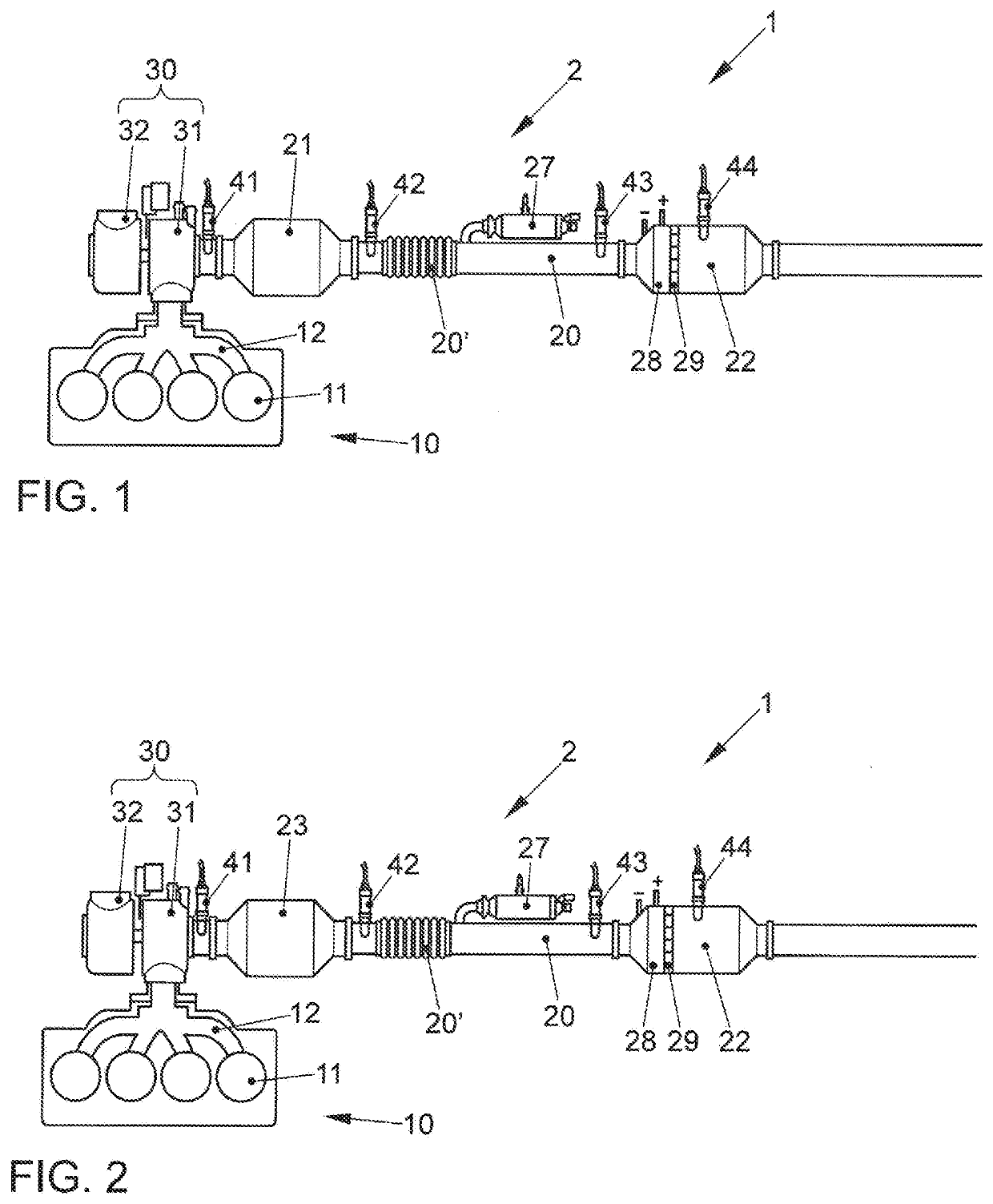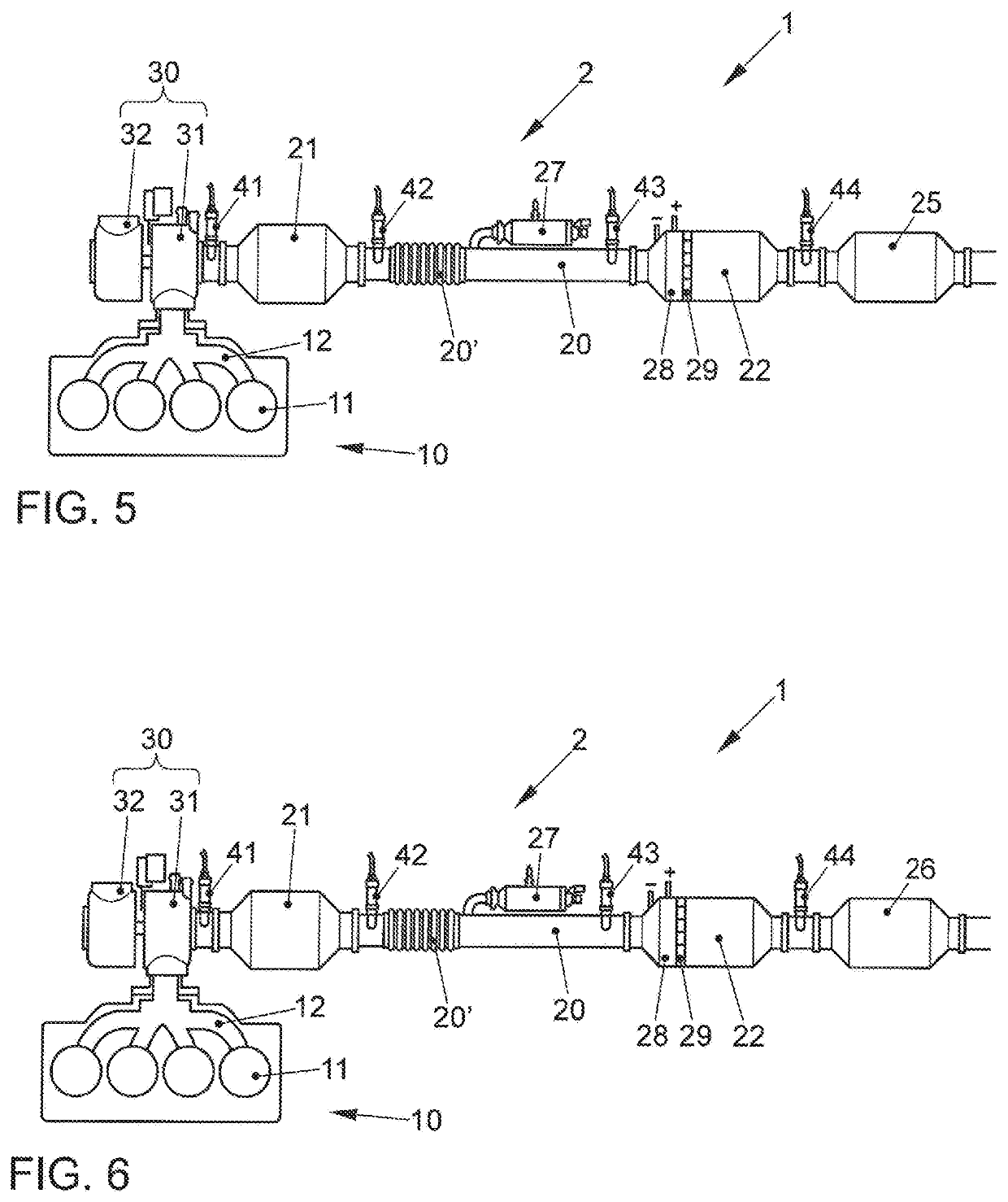Exhaust system for an internal combustion engine and method for operating the same
- Summary
- Abstract
- Description
- Claims
- Application Information
AI Technical Summary
Benefits of technology
Problems solved by technology
Method used
Image
Examples
first embodiment
[0045]To achieve a stoichiometric mixed gas with λm=1, in the method the internal combustion engine 10 is operated with a stoichiometric air-fuel mixture of λe=1 (setpoint variable), and the burner 27 is operated with a stoichiometric air-fuel mixture of Ab=1 (setpoint variable). In this way, both exhaust emission control devices 21, 22 are acted on with a stoichiometric exhaust gas, so that they both deliver optimal conversion power immediately after being activated. The internal combustion engine air-fuel mixture λe is regulated via a first lambda control loop by means of the first lambda sensor 41. The air-fuel mixture λb of the burner 27 is regulated via a second, separate lambda control loop by means of the third (or fourth) lambda sensor 42 and 43 (or 44).
[0046]According to a second embodiment of the method, the internal combustion engine 10 is operated slightly rich, for example with λe=0.9, and the burner 27 is operated slightly lean, in such a way that the mixed gas enterin...
second embodiment
[0047]FIG. 2 shows a vehicle 1 having an internal combustion engine 10 and an exhaust gas system 2 connected thereto according to the invention, wherein identical components are denoted by the same reference numerals as in FIG. 1 and are not explained again. The exhaust gas system 2 shown in FIG. 2 differs from FIG. 1 in that the first exhaust emission control device is designed as a four-way catalytic converter 23. This involves a particulate filter, in particular a gasoline engine particulate filter, for mechanical retention of particulate exhaust gas components; the filter substrate of the four-way catalytic converter has a three-way catalytic coating. In this way, the four-way catalytic converter 23 is able to reduce the four exhaust gas components comprising unburned hydrocarbons HC, carbon monoxide CO, nitrogen oxides NOx, and particulate emissions in the exhaust gas.
third embodiment
[0048]FIG. 3 shows a vehicle 1 having an internal combustion engine 10 and an exhaust gas system 2 connected thereto according to the invention, wherein identical components are denoted by the same reference numerals as in FIG. 1 and are not explained again. The exhaust gas system 2 shown in FIG. 3 differs from FIG. 1 in that a gasoline engine particulate filter 24 close to the engine is connected downstream from the first exhaust emission control device 21 (three-way catalytic converter), wherein the three-way catalytic converter 21 and the gasoline engine particulate filter 24 are in particular situated on a shared catalytic converter housing. The three-way catalytic converter 21 essentially corresponds to that from FIG. 1. The gasoline engine particulate filter 24 is strictly a particulate filter for mechanical retention of particulate exhaust gas components, without a catalytic coating. In this way, the combination of the first exhaust emission control device 21 and the particul...
PUM
 Login to View More
Login to View More Abstract
Description
Claims
Application Information
 Login to View More
Login to View More - R&D
- Intellectual Property
- Life Sciences
- Materials
- Tech Scout
- Unparalleled Data Quality
- Higher Quality Content
- 60% Fewer Hallucinations
Browse by: Latest US Patents, China's latest patents, Technical Efficacy Thesaurus, Application Domain, Technology Topic, Popular Technical Reports.
© 2025 PatSnap. All rights reserved.Legal|Privacy policy|Modern Slavery Act Transparency Statement|Sitemap|About US| Contact US: help@patsnap.com



